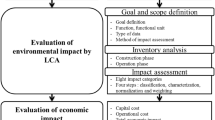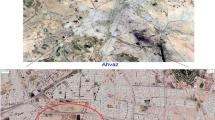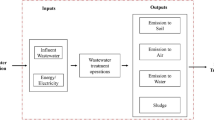Abstract
Literature review provides extensive studies focused on the life cycle assessment of wastewater treatment plants. However, few studies have a mitigation perspective, especially concerning water–energy–nutrient nexus or resource recovery systems for warm-weather countries. In this context, this paper aims to evaluate 10 wastewater treatment plants, based on an upflow anaerobic sludge blanket followed by a high rate aerobic pond. The recovery of biosolids, energy, and water, thermal and alkaline hydrolysis, CO2 recirculation to supplement carbon, and a membrane system for microalgae harvesting are tested. The paper uses the OpenLCA 1.9 software to evaluate the following categories: global warming potential and global temperature change potential (IPCC 2013); cumulative energy demand (Ecoinvent); acidification, human toxicity, marine and freshwater eutrophication, marine, freshwater and terrestrial ecotoxicity (ReCiPe (H) v.1.13 2008). Input data consist of a background (from Ecoinvent 3.5 and literature) and foreground mix. The work asses the following environmental aspects: energy, chemical materials use, transportation, and emissions. The results indicate that the scenario considering CO2 recirculation combined with thermal hydrolysis, with higher biosolids and energy production, has the lowest environmental impact for all categories. This result was due to materials manufacture and transportation, and comparative inputs added (natural gas energy, water, and fertilizer). Additionally, transportation variation only affects highly the iron chloride supply scenario. Emissions variation impacted directly on both IPCC categories for all scenarios, due to biogas losses accounted on the upflow anaerobic sludge blanket and anaerobic digester, while energy variation did not affect profoundly any of the scenarios.
Graphic abstract


Source: Elaborated by the author





Similar content being viewed by others
References
Associação Brasileira de Normas Técnicas (1992) Projeto de estação de tratamento de água para abastecimento público. NBR-12216. Rio de Janeiro, RJ
Amores MJ, Meneses M, Pasqualino J, Antón A, Castells F (2013) Environmental assessment of urban water cycle on Mediterranean conditions by LCA approach. J Clean Prod 43:84–92. https://doi.org/10.1016/j.jclepro.2012.12.033
Arashiro LT, Montero N, Ferrer I, Acién FG, Gómez C, Garfí M (2018) Life cycle assessment of high rate algal ponds for wastewater treatment and resource recovery. Sci Total Environ 622–623:1118–1130. https://doi.org/10.1016/j.scitotenv.2017.12.051
Brander M, Wylie C (2011) The use of substitution in attributional life cycle assessment. Greenh Gas Meas Manag 1:161–166. https://doi.org/10.1080/20430779.2011.637670
Buonocore E, Mellino S, De Angelis G, Liu G, Ulgiati S (2018) Life cycle assessment indicators of urban wastewater and sewage sludge treatment. Ecol Indic 94:13–23. https://doi.org/10.1016/j.ecolind.2016.04.047
Cabanelas IT, Ruiz J, Arbib Z, Chinalia FA, Garrido-Pérez C, Rogalla F, Nascimento IA, Perales JA (2013) Comparing the use of different domestic wastewaters for coupling microalgal production and nutrient removal. Bioresour Technol 131:429–436
Cassini ST, Francisco SA, Antunes PWP, Oss RN, Keller R (2017) Harvesting microalgal biomass grown in anaerobic sewage treatment effluent by the coagulation-flocculation method: Effect of pH. Braz Arch Biol Technol 60:1–12. https://doi.org/10.1590/1678-4324-2017160174
Cornejo PK, Zhang Q, Mihelcic JR (2013) Quantifying benefits of resource recovery from sanitation provision ina developing world setting. J Environ Manage 131:7–15. https://doi.org/10.1016/j.jenvman.2013.09.043
Funasa (2014) Manual De Cloração De Água Em Pequenas Comunidades Utilizando O Clorador Simplificado Desenvolvido Pela Funasa. Funasa, Brasília, p 40
De Feo G, Ferrara C (2017) A procedure for evaluating the most environmentally sound alternative between two on-site small-scale wastewater treatment systems. J Clean Prod 164:124–136. https://doi.org/10.1016/j.jclepro.2017.06.205
Di Bernardo L, Dantas ADB (2005) Methods and techniques of water treatment, vol 1, 2nd edn. Rio de Janeiro, Rima
Edelen A, Ingwersen, W (2016) Guidance on data quality assessment for life cycle inventory data. U.S. Environmental Protection Agency, Washington, EPA/600/R-16/096
El Ouarghi H, Praet E, Jupsin H, Vasel JL (2003) Comparison of oxygen and carbon dioxide balances in HRAP (high-rate algal ponds). Water Sci Technol 48:277–281. https://doi.org/10.2166/wst.2003.0131
Epa U (1994) Air emissions models for waste and wastewater. EPA contract no. 68D10118. Office of Air Quality Planning and Standards, Research Triangle Park
Fasaei F, Bitter JH, Slegers PM, van Boxtel AJB (2018) Techno-economic evaluation of microalgae harvesting and dewatering systems. Algal Res 31:347–362. https://doi.org/10.1016/j.algal.2017.11.038
Ferrón S, Ho DT, Johnson ZI, Huntley ME (2012) Air-water fluxes of N2O and CH4 during microalgae (Staurosira sp.) cultivation in an open raceway pond. Environ Sci Technol 46:10842–10848. https://doi.org/10.1021/es302396j
Hendrickson TP, Nguyen MT, Sukardi M, Miot A, Horvath A, Nelson KL (2015) Life-cycle energy use and greenhouse gas emissions of a building-scale wastewater treatment and nonpotable reuse system. Environ Sci Technol 49:10303–10311. https://doi.org/10.1021/acs.est.5b01677
Hobson J (2000) CH4 and N2O emissions from wastewater handling. In: Good practice guidance and uncertainty management in National Greenhouse Gas Inventories. Intergovernmental Panel on Climate Change (IPCC) Publications, Geneve
Incaper (2018) Dados médios da série histórica metereológica localizada no município de Vitória/ES. Incaper, 2017 and 2018. https://meteorologia.incaper.es.gov.br/graficos-da-serie-historica-vitoria. Accessed April 2019
ISO (2006) International Standard 14044:2006. Environ. Manag.—Life cycle assessement—Requir. Guidel. ISO 14044. Int Organ Stand 2006:652–668. https://doi.org/10.1007/s11367-011-0297-3
Jamwal P, Phillips D, Karlsrud K (2019) Assessing local materials for the treatment of wastewater in open drains. Water Sci Technol 79:895–904. https://doi.org/10.2166/wst.2019.105
Jørgensen PJ (2009) Biogas-green energy: process, design, energy supply, environment. Researcher for a Day
Jordão EP, Pessôa CA (2014) Tratamento de Esgotos Domésticos. 7th edn. Associação Brasileira de Engenharia Sanitária–ABES, Rio de Janeiro
Lamberti GG (2017) Solubilização de matéria orgânica e nutrientes do lodo algáceo de uma lagoa de estabilização através de processos hidrolíticos alcalino e térmico. Thesis, Federal University of Espírito Santo
Lehtoranta S, Vilpas R, Mattila TJ (2014) Comparison of carbon footprints and eutrophication impacts of rural on-site wastewater treatment plants in Finland. J Clean Prod 65:439–446. https://doi.org/10.1016/j.jclepro.2013.08.024
Longo S, d’Antoni BM, Bongards M, Chaparro A, Cronrath A, Fatone F, Lema JM, Mauricio-Iglesias M, Soares A, Hospido A (2016) Monitoring and diagnosis of energy consumption in wastewater treatment plants. A state of the art and proposals for improvement. Appl Energy 179:1251–1268. https://doi.org/10.1016/j.apenergy.2016.07.043
Lutterbeck CA, Kist LT, Lopez DR, Zerwes FV, Machado EL (2017) Life cycle assessment of integrated wastewater treatment systems with constructed wetlands in rural areas. J Clean Prod 148:527–536. https://doi.org/10.1016/j.jclepro.2017.02.024
Miller-Robbie L, Ramaswami A, Amerasinghe P (2017) Wastewater treatment and reuse in urban agriculture: exploring the food, energy, water, and health nexus in Hyderabad, India. Environ Res Lett. https://doi.org/10.1088/1748-9326/aa6bfe
Mo W, Zhang Q (2013) Energy-nutrients-water nexus: Integrated resource recovery in municipal wastewater treatment plants. J Environ Manage 127:255–267. https://doi.org/10.1016/j.jenvman.2013.05.007
Morera S, Corominas L, Rigola M, Poch M, Comas J (2017) Using a detailed inventory of a large wastewater treatment plant to estimate the relative importance of construction to the overall environmental impacts. Water Res 122:614–623. https://doi.org/10.1016/j.watres.2017.05.069
Niero M, Pizzol M, Bruun HG, Thomsen M (2014) Comparative life cycle assessment of wastewater treatment in Denmark including sensitivity and uncertainty analysis. J Clean Prod 68:25–35. https://doi.org/10.1016/j.jclepro.2013.12.051
Passos F, Uggetti E, Carrère H, Ferrer I (2014) Pretreatment of microalgae to improve biogas production: a review. Bioresour Technol 172:403–412. https://doi.org/10.1016/j.biortech.2014.08.114
Rebello TA, Roque RP, Gonçalves RF, Calmon JL, Queiroz LM (2021) Life cycle assessment of urban wastewater treatment plants: a critical analysis and guideline proposal. Water Sci Technol 83(3):501–514
Risch E, Gasperi J, Gromaire M-C, Chebbo G, Azimi S, Rocher V, Roux P, Rosenbaum RK, Sinfort C (2018) Impacts from urban water systems on receiving waters—how to account for severe wet-weather events in LCA? Water Res 128:412–423. https://doi.org/10.1016/j.watres.2017.10.039
Santiago ADF (2013) Avaliação do desempenho de lagoas de alta taxa no tratamento de esgoto pré-desinfectado submetidas a diferentes níveis de radiação solar. Ph.D. dissertation, Federal University of Viçosa
Scarpatti M, de Lima AC, Madureira C et al (2014) Energia solar no Espírito Santo: tecnologias, aplicações e oportunidades. Agência de Serviços Públicos de Energia do Estado do Espírito Santo (ASPE), Vitória
Shiu H-Y, Lee M, Chiueh P-T (2017) Water reclamation and sludge recycling scenarios for sustainable resource management in a wastewater treatment plant in Kinmen islands, Taiwan. J Clean Prod 152:369–378. https://doi.org/10.1016/j.jclepro.2017.03.110
Sperling MV, De Lemos Chernicharo CA (2005) Biological wastewater treatment in warm climate regions. IWA Publ. https://doi.org/10.5860/CHOICE.45-2633
Sullivan D, Cogger C, Bary A (2015) Fertilizing with biosolids. Pacific Northwest Ext. 1–18
Technical Committee ISO/TC 207 (2006) Life cycle assessment—principles and framework. Iso 14040 3:28.https://doi.org/10.1002/jtr
Teodosiu C, Barjoveanu G, Sluser BR, Popa SAE, Trofin O (2016) Environmental assessment of municipal wastewater discharges: a comparative study of evaluation methods. Int J Life Cycle Assess 21:395–411. https://doi.org/10.1007/s11367-016-1029-5
Tsai DDW, Ramaraj R, Chen PH (2016) Carbon dioxide bio-fixation by algae of high rate pond on natural water medium. Ecol Eng 92:106–110. https://doi.org/10.1016/j.ecoleng.2016.03.021
Weidema B (2014) Has ISO 14040/44 failed its role as a standard for life cycle assessment? J Ind Ecol 18:324–326. https://doi.org/10.1111/jiec.12139
Weidema BP, Wesnæs MS (1996) Data quality management for life cycle inventories-an example of using data quality indicators. J Clean Prod 4:167–174. https://doi.org/10.1016/S0959-6526(96)00043-1
Wyatt NB, Gloe LM, Brady PV, Hewson JC, Grillet AM, Hankins MG, Pohl PI (2012) Critical conditions for ferric chloride-induced flocculation of freshwater algae. Biotechnol Bioeng 109:493–501. https://doi.org/10.1002/bit.23319
Xue X, Hawkins TR, Schoen ME, Garland J, Ashbolt NJ (2016) Comparing the life cycle energy consumption, globalwarming and eutrophication potentials of several water and waste service options. Water (switzerland). https://doi.org/10.3390/w8040154
Acknowledgements
This study was partly financed by the Coordenação de Aperfeiçoamento de Pessoal de Nível Superior (College and Graduate Education Improvement Coordination)—Brazil (CAPES)—Finance Code 001. The authors also acknowledge the financial support given by Fundação de Amparo à Pesquisa e Inovação do Espírito Santo (Espírito Santo Research and Innovation Support Foundation—FAPES) Project 107/2019.
Author information
Authors and Affiliations
Contributions
Thais Ayres Rebello: Conceptualization, Investigation, Writing—Original Draft, Visualization, Writing—Review & Editing, Funding acquisition. Ricardo Franci Gonçalves: Supervision, Conceptualization, Writing—Review & Editing, Project administration, Funding acquisition. João Luiz Calmon: Supervision, Conceptualization, Writing—Review & Editing, Project administration, Funding acquisition.
Corresponding author
Additional information
Editorial responsibility: Samareh Mirkia.
Supplementary Information
Below is the link to the electronic supplementary material.
Rights and permissions
About this article
Cite this article
Rebello, T.A., Gonçalves, R.F. & Calmon, J.L. Mitigation of environmental impacts in warm-weather wastewater treatment plants using the life cycle assessment tool. Int. J. Environ. Sci. Technol. 19, 4763–4778 (2022). https://doi.org/10.1007/s13762-021-03430-y
Received:
Revised:
Accepted:
Published:
Issue Date:
DOI: https://doi.org/10.1007/s13762-021-03430-y




